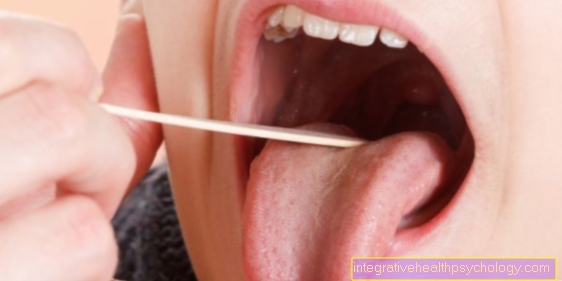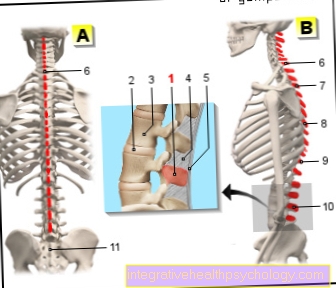Contagion with mouth rot
introduction
Almost everyone knows herpes as a crusty change on the lip. It is a symptom of the herpes virus that often recurs during stress. Over 90% of the population carries the virus. Many people become infected unnoticed.
However, the initial infection can also lead to the outbreak of a clinical picture, the so-called "mouth rot" ("herpetic gingivostomatitis"). Lip herpes is known to be contagious, and so is oral rot.

Oral rot is so contagious
The virus that causes oral rot is contagious. It is transmitted quickly and most of the population has it. However, this does not mean that someone who gets infected from someone who has oral rot will also get oral rot. The initial infection with the so-called herpes virus usually goes unnoticed. Most people know the crusty change on the lip as one of the symptoms of the herpes virus.
This often occurs in stressful situations, or in other situations where the immune system is weakened. As with cold sores, mouth rot signals that the body is dealing with the virus. Since you develop defense cells against the viruses after the illness, you usually don't get sick a second time. People who have already suffered from oral rot cannot get infected again. If this does happen, further examinations are necessary and possibly more serious deficits in the immune system of the re-ill person to be examined. It is not known why not everyone who is infected with the virus develops mouth rot. The viruses are contagious for up to 12 days.
Find out more about: Herpes in the mouth
Path of infection
Herpes viruses are transmitted through close physical contact. This is also called contact infection. This also includes the well-known droplet infection, i.e. the virus is also transmitted via saliva, among other things. The carriers excrete the virus in their saliva at irregular intervals and people suffering from oral rot release it into the environment throughout the course of the disease. Therefore, when you are sick, you should pay particular attention to hygiene.
This means that you can get infected while kissing and sharing the cutlery, the glass or the bottle. The parents are often infected as early as infancy when they kiss the child or use their own handkerchief, for example, to blow the child's nose. Small children in particular tend to put a lot of toys in their mouths and the pacifier is also a source of infection if someone else puts it in their mouth. This should be avoided at all times in order to keep the germ load of the child as low as possible.
Read more on the topic: Course of the mouth rot
incubation period
The incubation period of oral rot, i.e. the time that elapses between the first contact with the virus and the onset of the disease, can vary between two and nine days.
However, four to six days are most commonly given. The incubation time also depends on the state of health of the infected person and how quickly their immune system can fight the virus.
You might also be interested in this topic: Mouth rot in adults,
How long is mouth rot contagious?
In the case of oral rot, one speaks of an approximate incubation period of four to six days. After that, a general feeling of illness occurs and after a further 2 days the typical changes in the oral mucous membrane usually occur. This lasts about 5 days and there is a constant improvement in the general condition.
After one to two weeks you will feel fit again. This means that the body's exposure to the virus takes two to three weeks. In this time window, the infected person excretes the virus, that is, roughly one can speak of a two-week risk of infection.
More on this topic: Duration of mouth rot
This is how contagious mouth rot is for toddlers and babies
Oral rot is most common in children aged 7 months to 6 years.
Before the 7th month of life, babies usually still have antibodies, i.e. defense cells, against the virus, which they ingest through the mother's milk. Since this protection is no longer available after breastfeeding and the infection happens quickly and frequently, most people fall ill with oral rot in childhood. After that they have their own antibodies and only in very rare cases does the disease break out again.
It is therefore very rare in adulthood. If the child's immune system is weakened, especially after measles, scarlet fever and whooping cough, there is an increased risk of developing oral rot. Then the disease can take a more dramatic course than usual (meningitis). Finger and thumb sucking should also be avoided during acute oral rot, as the virus can also spread to the finger.
Read more on the topic:
- Mouth rot in the baby
- Mouth rot in children / toddlers
This is how contagious mouth rot is for siblings
In order to answer this question, one must first understand that the mother's antibodies are only briefly passed on to the child via breast milk. Antibodies cannot be passed on in the sense that once a parent has contracted oral rot and has formed antibodies, the information is passed on to the child. Every child must be viewed as a separate organization, who must have dealt with the virus themselves once in order to be immune to it later.
So siblings can infect each other. Especially at the age at which the children are particularly likely to develop oral rot, i.e. between 7 months and six years, siblings often play intensively with each other and the risk of infecting each other is increased when they fight each other.
These articles might also interest you:
- Symptoms of herpes
- Baby herpes - how dangerous is it?
How dangerous is mouth rot for pregnant women?
At first, pregnant women do not need to worry if they develop oral rot. The unborn child usually does not come into contact with the viruses that are secreted from the oral cavity. There are, however, exceptions in which caution is required. If there is severe viraemia, i.e. if there are many virus cells in the blood, the virus can in rare cases penetrate the placenta and spread into the child's bloodstream. However, this only happens very rarely.
Since oral rot is the first infection with the herpes virus, the mother cannot protect her child sufficiently with her body's own antibodies. She still has to create it herself. If the mother falls ill with oral rot shortly before birth, it goes without saying that direct contact should be avoided during birth. If you suffer from oral rot yourself, you should not kiss the newborn or put your hands to the mouth and then touch the baby.
However, the most common infection of the newborn by the mother is genital herpes. This is triggered by the same virus as oral rot and represents a real obstacle in the genital region in the birth canal. A caesarean section is appropriate here.
Also read the article on the topic: Duration of genital herpes
How can you prevent infection?
Since the virus that triggers oral rot is mainly transmitted via saliva, all objects that come into contact with the mouth are a source of infection. For example, make sure not to share any cutlery or crockery. You can also get infected through a used handkerchief or the towel of a herpes virus carrier. It is important to ensure that small children do not share pacifiers.
Toys that are put in the mouth are also at risk of infection. Of course, the virus is also transmitted through kissing. If you suffer from oral rot, you should avoid kissing and the closest physical contact. In summary, it is very important to pay attention to hygiene. Those who are already carriers of the virus, over 90% of the population, and who have already had oral rot, or who are carriers without being sick, are usually not at risk of getting oral rot again.





























